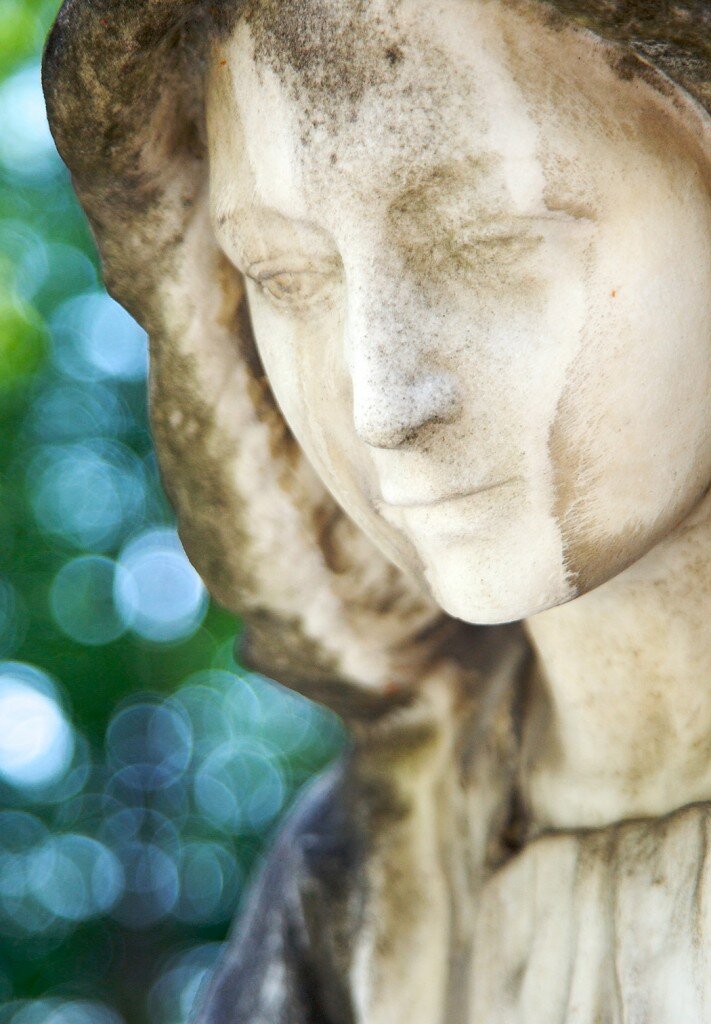 I have 53,319 photos in my primary digital photo library. These are photos I have taken between 2002 and the present. I don't expect you to be impressed with this number - I'm not sure I am. I think many of these photos should be discarded.But, because I run out of things to post here, I am happy I have so many photos because it allows me to "throw a dart" when I'm stymied. Today, I randomly picked photos from May, 2009, and this one jumped out at me. It was taken at the amazing Mirogoj cemetery in Zabreb, Croatia. I wish I could tell you more about this monument but I can't.I can tell you that I like the woman's gentle demeanor and that I also like the great bokeh in the backround. Finally, I like the fact that the background is in color and that the woman seems to be in tones of sepia, which seems appropriate for a stoney figure mourning in a graveyard.
I have 53,319 photos in my primary digital photo library. These are photos I have taken between 2002 and the present. I don't expect you to be impressed with this number - I'm not sure I am. I think many of these photos should be discarded.But, because I run out of things to post here, I am happy I have so many photos because it allows me to "throw a dart" when I'm stymied. Today, I randomly picked photos from May, 2009, and this one jumped out at me. It was taken at the amazing Mirogoj cemetery in Zabreb, Croatia. I wish I could tell you more about this monument but I can't.I can tell you that I like the woman's gentle demeanor and that I also like the great bokeh in the backround. Finally, I like the fact that the background is in color and that the woman seems to be in tones of sepia, which seems appropriate for a stoney figure mourning in a graveyard.
Europe
Back To Paris
 This is the palace at the Luxembourg Gardens in Paris, France. In this photo I am showing obedience to the principle of "zones" in a landscape photo: the idea that there is something in the front, something in the middle and something in the back. I guess it makes something that is two dimensional seem more three dimensional.
This is the palace at the Luxembourg Gardens in Paris, France. In this photo I am showing obedience to the principle of "zones" in a landscape photo: the idea that there is something in the front, something in the middle and something in the back. I guess it makes something that is two dimensional seem more three dimensional.
Mummy Cases
A Beautiful Cataclysm
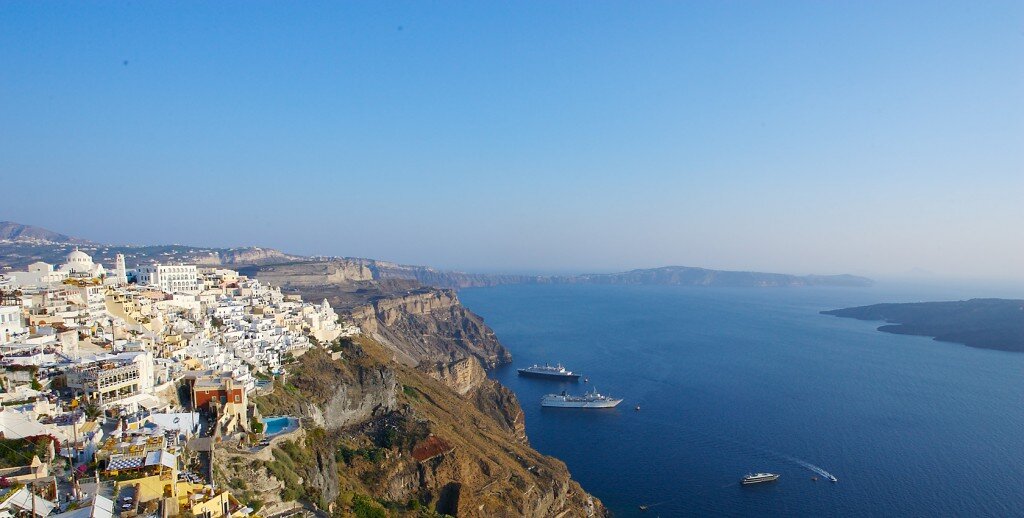 Santorini is one of the most glamorous islands anywhere in the world. The glamor of its setting and of the white villas, hotels and restaurants perched on steep cliffs looking west over the Aegean sea are what attract tourists like me, my wife and my students, who were there in 2004 on a cruise of the the Greek islands.But there was little glamor in the volcanic eruption that blew away a large portion of the island in 1628 BC. Not only did it destroy a substantial part of the island (then called Thera) but it also created a tsunami wave as high at 100 feet that rolled across the island of Crete to the south, destroying the great pre-Greek civilization that developed there. In fact, this could be where the legend of Atlantis began.In this photo you can see the white washed buildings which are in some cases perched on precipitous cliffs. You can also see part of the crescent shaped harbor that lies where the volcano once rose out of the sea. For the ride up to the high city, one can choose a modern cable car or a time-tested conveyance: donkeys. We took donkeys up and the cable car down.Sadly, we only had a few short hours on the island before our cruise boat moved on. I hope you can stay longer.
Santorini is one of the most glamorous islands anywhere in the world. The glamor of its setting and of the white villas, hotels and restaurants perched on steep cliffs looking west over the Aegean sea are what attract tourists like me, my wife and my students, who were there in 2004 on a cruise of the the Greek islands.But there was little glamor in the volcanic eruption that blew away a large portion of the island in 1628 BC. Not only did it destroy a substantial part of the island (then called Thera) but it also created a tsunami wave as high at 100 feet that rolled across the island of Crete to the south, destroying the great pre-Greek civilization that developed there. In fact, this could be where the legend of Atlantis began.In this photo you can see the white washed buildings which are in some cases perched on precipitous cliffs. You can also see part of the crescent shaped harbor that lies where the volcano once rose out of the sea. For the ride up to the high city, one can choose a modern cable car or a time-tested conveyance: donkeys. We took donkeys up and the cable car down.Sadly, we only had a few short hours on the island before our cruise boat moved on. I hope you can stay longer.
Ian the Ex-Pat
 We had driven off the "beaten path" while exploring the Greek island of Corfu a few years ago. As is often the case, we came to an intersection at a small village with one sign pointing south saying that our destination was that way. But there was another sign on the same pole pointing north to the same town.We were pondering this paradox when a man ambled over to our car. A helpful Greek? Does he speak English? My questions were answered when he said, in a clean British accent, "Lost?" And I said, "Kind of."His name was Ian and he had worked for a major British corporation. But he referred to himself as a British ex-patriot and now called this little town his home. He said he was enjoying the pace of the simple life and invited us to sample it by joining him for coffee at the small cafe along main street. I had my first ever "Greek coffee" and remember little of the conversation Deb and I had with Ian. I do remember the grit of the coffee and the silence of this place that Ian had found.When we left, Ian invited us to come back some day and stay at his apartment. But I don't remember the name of the town. And, even if I remembered it, I doubt that Greek road signs would get us there.
We had driven off the "beaten path" while exploring the Greek island of Corfu a few years ago. As is often the case, we came to an intersection at a small village with one sign pointing south saying that our destination was that way. But there was another sign on the same pole pointing north to the same town.We were pondering this paradox when a man ambled over to our car. A helpful Greek? Does he speak English? My questions were answered when he said, in a clean British accent, "Lost?" And I said, "Kind of."His name was Ian and he had worked for a major British corporation. But he referred to himself as a British ex-patriot and now called this little town his home. He said he was enjoying the pace of the simple life and invited us to sample it by joining him for coffee at the small cafe along main street. I had my first ever "Greek coffee" and remember little of the conversation Deb and I had with Ian. I do remember the grit of the coffee and the silence of this place that Ian had found.When we left, Ian invited us to come back some day and stay at his apartment. But I don't remember the name of the town. And, even if I remembered it, I doubt that Greek road signs would get us there.
Our Portuguese Friend
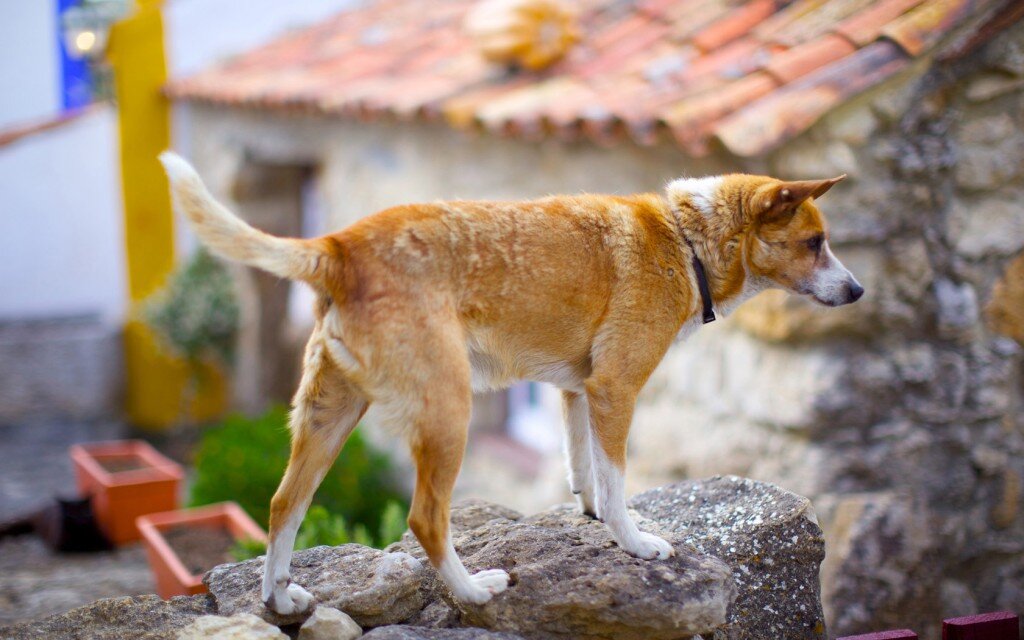 One of the best discoveries of all of our travels to Europe is a small village in Portugal north of Lisbon with stone houses that have been converted to small apartments for tourists. The name of the little town is Aldeia da Mata Pequena and we stayed in the apartment named "Caso do Jasmin." Among the ammenities were antique decorations, a kitchen sink carved out of stone and warm bread served each morning by the owner.Another amenity was the town dog, whom we nicknamed "Sparky" because we couldn't say her real name. She would come to visit when we were out on our little back patio. She wouldn't respond to our English but did accept our small gifts of bread and cheese. When she barked, I'm guessing she spoke Portuguese.
One of the best discoveries of all of our travels to Europe is a small village in Portugal north of Lisbon with stone houses that have been converted to small apartments for tourists. The name of the little town is Aldeia da Mata Pequena and we stayed in the apartment named "Caso do Jasmin." Among the ammenities were antique decorations, a kitchen sink carved out of stone and warm bread served each morning by the owner.Another amenity was the town dog, whom we nicknamed "Sparky" because we couldn't say her real name. She would come to visit when we were out on our little back patio. She wouldn't respond to our English but did accept our small gifts of bread and cheese. When she barked, I'm guessing she spoke Portuguese.
Old Stone Faces
 There is a short story by Nathaniel Hawthorne entitled "The Great Stone Face" which I remember being assigned by a teacher who scared me more than any teacher I ever had. As I remember her, she generally wore an expression of menace and she never smiled. In my mind, she was the real "Stone Face," though she could have also been a double for the Wicked Witch of the North in The Wizard of Oz.Of course all of this has nothing to do with this photo, though there are faces portrayed in stone. Where is this? Venice. Who are these people? If I had been listening to our tour guide instead of taking photos, I might know. But I do know that all of these stoney people look friendlier than my scary teacher.
There is a short story by Nathaniel Hawthorne entitled "The Great Stone Face" which I remember being assigned by a teacher who scared me more than any teacher I ever had. As I remember her, she generally wore an expression of menace and she never smiled. In my mind, she was the real "Stone Face," though she could have also been a double for the Wicked Witch of the North in The Wizard of Oz.Of course all of this has nothing to do with this photo, though there are faces portrayed in stone. Where is this? Venice. Who are these people? If I had been listening to our tour guide instead of taking photos, I might know. But I do know that all of these stoney people look friendlier than my scary teacher.
Hvar Chamber Of Commerce?
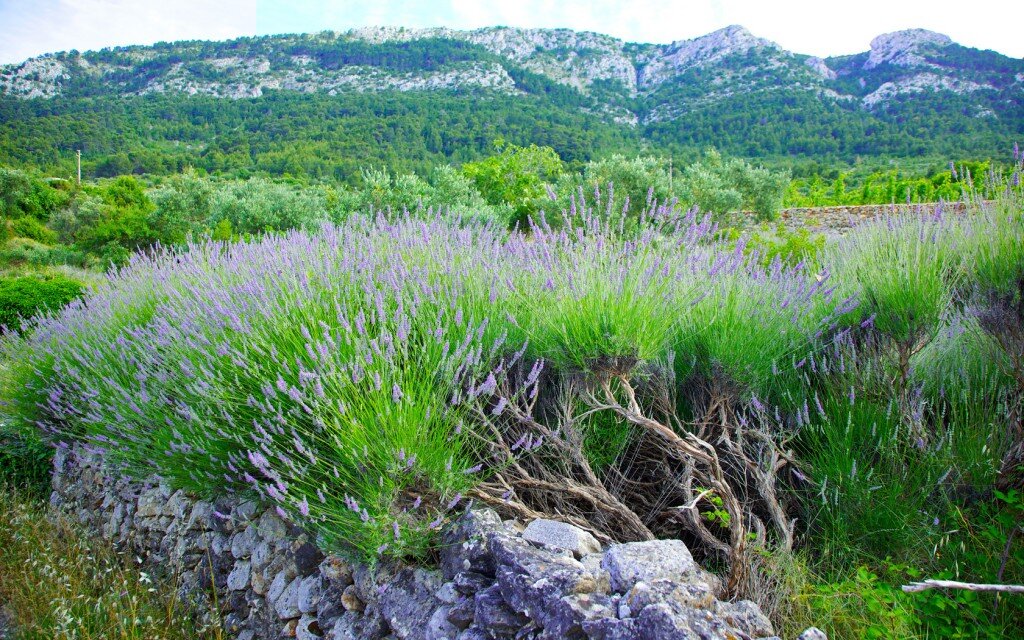 Just to make it clear, I am not employed by any organization that represents Hvar tourism. Or Croatian tourism. But I am a fan of Hvar, Croatia. So here's yet another shot of venerable gray stone walls and fragrant lavender.If you noticed yesterday's post, I had said that I didn't know where the city portrayed was on the island. Thanks to someone familiar with the island, I am able to put it more firmly on my mental map. This photo is typical of many locales on the island, though I can say that it was taken fairly close to yesterday's photo.
Just to make it clear, I am not employed by any organization that represents Hvar tourism. Or Croatian tourism. But I am a fan of Hvar, Croatia. So here's yet another shot of venerable gray stone walls and fragrant lavender.If you noticed yesterday's post, I had said that I didn't know where the city portrayed was on the island. Thanks to someone familiar with the island, I am able to put it more firmly on my mental map. This photo is typical of many locales on the island, though I can say that it was taken fairly close to yesterday's photo.
Hillside Town - Hvar Island
Wood Piles and Satellite TV?
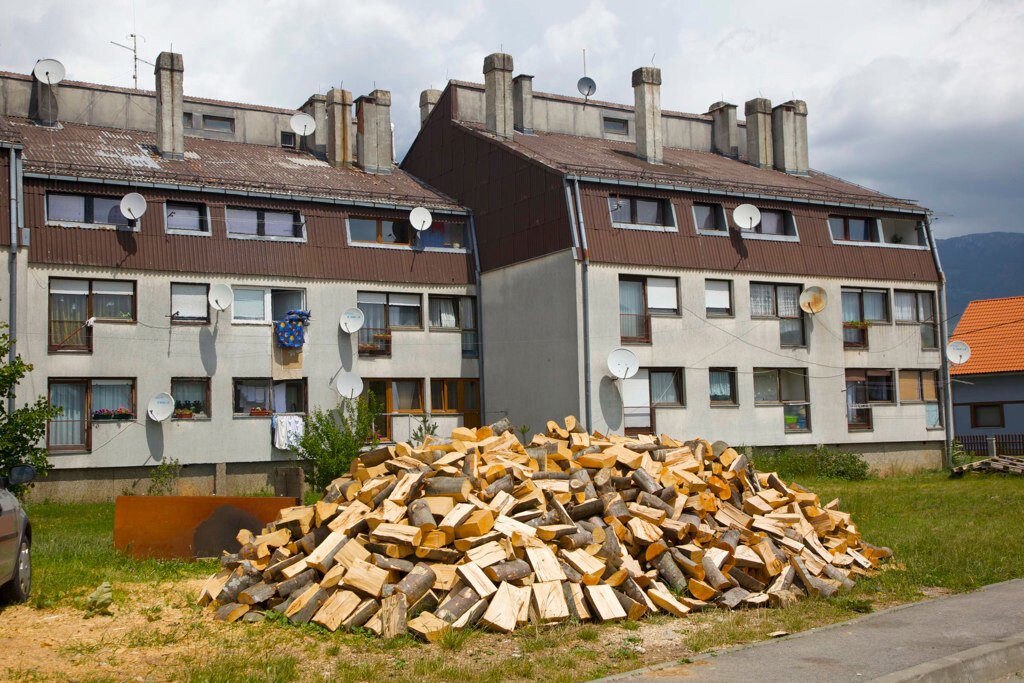 This photo was taken in a small Croatian city south of the Plitvice Lakes National Park. Instead of driving through town, Deb and I turned off the main highway and wandered through the residential area, which included these moldering Soviet-era apartment blocks. Scattered in this neighborhood there were several serious woods piles like this, in addition to neatly stacked piles in covered areas on the opposite sides of these buildings.This wood is to provide real heat in winter. I am struck by the paradox of wood piles outside of buildings that have satellite TV antennae mounted on the walls. Warmth and television both help South Dakotans get through winter, too!
This photo was taken in a small Croatian city south of the Plitvice Lakes National Park. Instead of driving through town, Deb and I turned off the main highway and wandered through the residential area, which included these moldering Soviet-era apartment blocks. Scattered in this neighborhood there were several serious woods piles like this, in addition to neatly stacked piles in covered areas on the opposite sides of these buildings.This wood is to provide real heat in winter. I am struck by the paradox of wood piles outside of buildings that have satellite TV antennae mounted on the walls. Warmth and television both help South Dakotans get through winter, too!
The Journalist
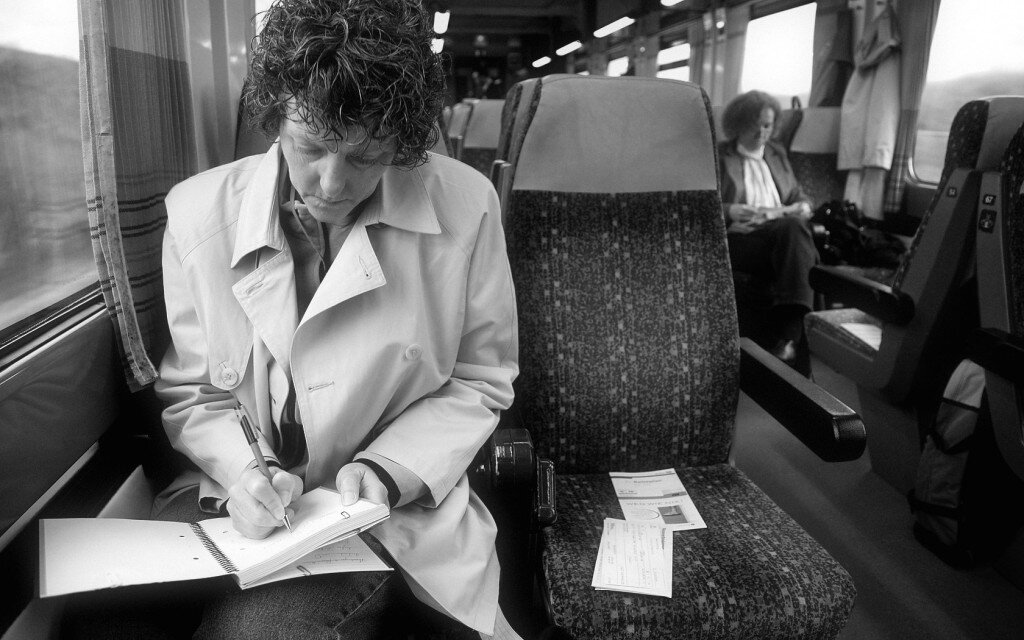 When Deb and I travel to Europe, I generally create the itinerary and take care of all the details before we leave: plane and train tickets, hotels and auto rentals. Once there, when we aren't on a train or plane, I drive.So "What does Deb do?" you ask. Aside from giving me constant advice and helping me keep track of lenses, chargers and ipods, she participates in our "travel democracy." Nobody leads and nobody follows. Instead we jointly decide what we will see and do on any given day. It works well.Beyond, that, I would say that Deb is the left brain and I'm the right. She writes about our travels and I picture them. This photo, of course, is evidence of our symbiosis.For those who might wonder, in this shot, we are on a train going from Berlin to Dresden, Germany. I am taking a picture of Deb writing in her journal while a blurry women in the background reads a book.Why did I convert the photo to black and white? It looks more "journalistic."
When Deb and I travel to Europe, I generally create the itinerary and take care of all the details before we leave: plane and train tickets, hotels and auto rentals. Once there, when we aren't on a train or plane, I drive.So "What does Deb do?" you ask. Aside from giving me constant advice and helping me keep track of lenses, chargers and ipods, she participates in our "travel democracy." Nobody leads and nobody follows. Instead we jointly decide what we will see and do on any given day. It works well.Beyond, that, I would say that Deb is the left brain and I'm the right. She writes about our travels and I picture them. This photo, of course, is evidence of our symbiosis.For those who might wonder, in this shot, we are on a train going from Berlin to Dresden, Germany. I am taking a picture of Deb writing in her journal while a blurry women in the background reads a book.Why did I convert the photo to black and white? It looks more "journalistic."
Safe Harbor
 I apologize to all of my disciplined readers who may find that my blog appears at irregular times lately. It seems that when I get up these days, I start working on planning for my 8:30 history class instead of looking for a new photo to post. I'll try to do both in the morning from now on.Anyway, this photo was taken in a small village on the island of Hvar, Croatia. Like many small villages on islands along the Dalmatian coast, Vrboska is scenic, inviting and a good place for sailors to spend some time. Deb and I arrived via ferry and automobile, but maybe next summer we'll sail here. . .
I apologize to all of my disciplined readers who may find that my blog appears at irregular times lately. It seems that when I get up these days, I start working on planning for my 8:30 history class instead of looking for a new photo to post. I'll try to do both in the morning from now on.Anyway, this photo was taken in a small village on the island of Hvar, Croatia. Like many small villages on islands along the Dalmatian coast, Vrboska is scenic, inviting and a good place for sailors to spend some time. Deb and I arrived via ferry and automobile, but maybe next summer we'll sail here. . .


